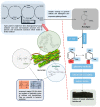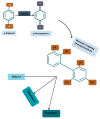Aptitude of Oxidative Enzymes for Treatment of Wastewater Pollutants: A Laccase Perspective
- PMID: 31151229
- PMCID: PMC6600482
- DOI: 10.3390/molecules24112064
Aptitude of Oxidative Enzymes for Treatment of Wastewater Pollutants: A Laccase Perspective
Abstract
Natural water sources are very often contaminated by municipal wastewater discharges which contain either of xenobiotic pollutants and their sometimes more toxic degradation products, or both, which frustrates the universal millenium development goal of provision of the relatively scarce pristine freshwater to water-scarce and -stressed communities, in order to augment their socioeconomic well-being. Seeing that both regulatory measures, as regards the discharge limits of wastewater, and the query for efficient treatment methods remain unanswered, partially, the prospects of enzymatic treatment of wastewater is advisable. Therefore, a reconsideration was assigned to the possible capacity of oxidative enzymes and the respective challenges encountered during their applications in wastewater treatment, and ultimately, the prospects of laccase, a polyphenol oxidase that oxidizes aromatic and inorganic substrates with electron-donating groups in treatment aromatic contaminants of wastewater, in real wastewater situations, since it is assumed to be a vehicle for a greener community. Furthermore, the importance of laccase-driven catalysis toward maintaining mass-energy balance, hence minimizing environmental waste, was comprehensibly elucidated, as well the strategic positioning of laccase in a model wastewater treatment facility for effective treatment of wastewater contaminants.
Keywords: environomics; laccase; oxidative enzymes; wastewater pollutants; wastewater treatment.
Conflict of interest statement
The authors declare no conflict of interest.
Figures






Similar articles
-
Ligninolytic enzymes: Versatile biocatalysts for the elimination of endocrine-disrupting chemicals in wastewater.Microbiologyopen. 2018 Dec;7(6):e00722. doi: 10.1002/mbo3.722. Epub 2018 Oct 17. Microbiologyopen. 2018. PMID: 30328673 Free PMC article. Review.
-
Enzymatic degradability of diclofenac ozonation products: A mechanistic analysis.Chemosphere. 2024 Jun;358:142112. doi: 10.1016/j.chemosphere.2024.142112. Epub 2024 Apr 25. Chemosphere. 2024. PMID: 38677613
-
Laccase grafted membranes for advanced water filtration systems: a green approach to water purification technology.Crit Rev Biotechnol. 2018 Sep;38(6):883-901. doi: 10.1080/07388551.2017.1417234. Epub 2017 Dec 27. Crit Rev Biotechnol. 2018. PMID: 29281904 Review.
-
A hybrid bioreactor based on insolubilized tyrosinase and laccase catalysis and microfiltration membrane remove pharmaceuticals from wastewater.Chemosphere. 2018 Jun;201:749-755. doi: 10.1016/j.chemosphere.2018.03.022. Epub 2018 Mar 5. Chemosphere. 2018. PMID: 29549858
-
Laccases from Marine Organisms and Their Applications in the Biodegradation of Toxic and Environmental Pollutants: a Review.Appl Biochem Biotechnol. 2019 Feb;187(2):583-611. doi: 10.1007/s12010-018-2829-9. Epub 2018 Jul 16. Appl Biochem Biotechnol. 2019. PMID: 30009326 Review.
Cited by
-
Sustainability potentials of novel laccase tinctures from Stenotrophomonas maltophilia BIJ16 and Bordetella bronchiseptica HSO16: From dye decolourization to denim bioscouring.Biotechnol Rep (Amst). 2019 Dec 3;25:e00409. doi: 10.1016/j.btre.2019.e00409. eCollection 2020 Mar. Biotechnol Rep (Amst). 2019. PMID: 31886141 Free PMC article.
-
Recent Developments in the Immobilization of Laccase on Carbonaceous Supports for Environmental Applications - A Critical Review.Front Bioeng Biotechnol. 2021 Dec 6;9:778239. doi: 10.3389/fbioe.2021.778239. eCollection 2021. Front Bioeng Biotechnol. 2021. PMID: 34938721 Free PMC article. Review.
-
Design of a Biocatalytic Filter for the Degradation of Diclofenac and Its Ozonation Products.Eng Life Sci. 2025 May 2;25(5):e70024. doi: 10.1002/elsc.70024. eCollection 2025 May. Eng Life Sci. 2025. PMID: 40321240 Free PMC article.
-
Applications and immobilization strategies of the copper-centred laccase enzyme; a review.Heliyon. 2023 Jan 25;9(2):e13156. doi: 10.1016/j.heliyon.2023.e13156. eCollection 2023 Feb. Heliyon. 2023. PMID: 36747551 Free PMC article. Review.
-
Novel Magnetic Polymeric Filters with Laccase-Based Nanoparticles for Improving Congo Red Decolorization in Bioreactors.Polymers (Basel). 2022 Jun 8;14(12):2328. doi: 10.3390/polym14122328. Polymers (Basel). 2022. PMID: 35745904 Free PMC article.
References
-
- Martin J., Camacho-Muñoz D., Santos J.L., Aparicio I., Alonso E. Occurence of pharmaceutical compounds in wastewater and sludge from wastewater treatment plants: Removal and ecotoxicological impact of wastewater discharges and sludge disposal. J. Hazard. Mater. 2012;239–240:40–47. doi: 10.1016/j.jhazmat.2012.04.068. - DOI - PubMed
-
- Nguyen L.N., Hai F.I., Price W.E., Leusch F.D.L., Roddick F., McAdam E.J., Magram S.F., Nghiem L.D. Continuous biotransformation of bisphenol A and diclofenac by laccase in an enzymatic membrane reactor. Int. Biodeteriorat. Biodegrad. 2014;95:25–32. doi: 10.1016/j.ibiod.2014.05.017. - DOI
-
- Bolong N., Ismail A.F., Salim M.R., Matsuura T. A review of the effects of emerging contaminants in wastewater and options for their removal. Desalination. 2009;239:229–246. doi: 10.1016/j.desal.2008.03.020. - DOI
Publication types
MeSH terms
Substances
Grants and funding
LinkOut - more resources
Full Text Sources
Medical

